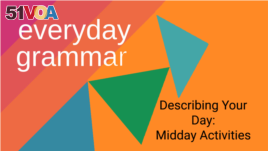07 October 2021
Imagine you want to describe your day. Perhaps you have an English test that asks about what you do regularly. Or maybe you just want to tell a friend about your day's activities.
In this Everyday Grammar, we will explore how you can describe the middle of your day. You will learn about how things that happen in the middle of the day connect with grammar. In particular, you will learn about direct objects, indirect objects and basic sentence structures.

But first, let's explore some important terms and ideas.
Noun phrases
A noun phrase is a group of words that acts like a noun in the sentence.
Noun phrases can appear as the subject of the sentence or in the predicate – the part of the sentence that says something about the subject.
Consider this example:
I am eating my lunch.
The noun phrase my lunch appears in the predicate, after the verb eat.
When noun phrases appear in the predicate, they can play the part of the direct or indirect object.
The direct object is the receiver of the verb's action.
In our example, I am eating my lunch, the noun phrase my lunch is the direct object.
Now consider how statements about the middle of the day might connect with direct objects.
Imagine you are telling someone about what you do every day.
You could say:
I eat lunch.
I drink tea.
I call my friends.
I use my phone.
I take a nap.
All of these statements follow the same basic structure: subject, verb and noun or noun phrase – the direct object.
Indirect objects
Now, let's explore indirect objects. The indirect object is the receiver of the direct object.
Consider the following statement:
I send my friends text messages.
In this case, the direct object is text messages. The indirect object is my friends.
You might make any number of statements about midday activities by using direct and indirect objects.
For example:
I give my mom a call.
Please note that indirect objects can also appear after prepositions, as in:
I take lunch to my brother.
If you are having trouble identifying direct and indirect objects, ask yourself what the different noun phrases refer to.
For example, do the subject and noun phrases after the verb in the predicate refer to the same thing or different things?
In our example, I take lunch to my brother, the subject is I, the direct object is lunch, and the indirect object is my brother. These all refer to three different things.
The next time you are listening to English speakers describing their days, pay careful attention to the kinds of sentences they use. Note how they use direct and indirect objects.
With time, you will master basic sentence structures that will permit you to communicate all kinds of ideas – perhaps about the middle of the day, or about many other things as well.
I'm John Russell.
John Russell wrote this lesson for VOA Learning English. Bryan Lynn was the editor.
_____
Words in This Story
grammar – n. the entire system or structure of a language
nap – n. a short period of sleep especially during the day
refer to – phrasal verb to have a direct connection or relationship to (something)
master – v. to get the knowledge and skill that allows you to do, use, or understand (something) very well












